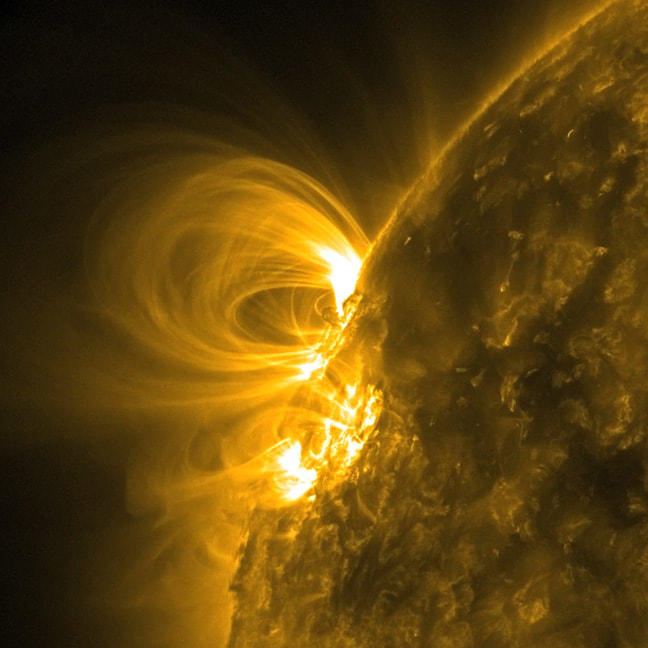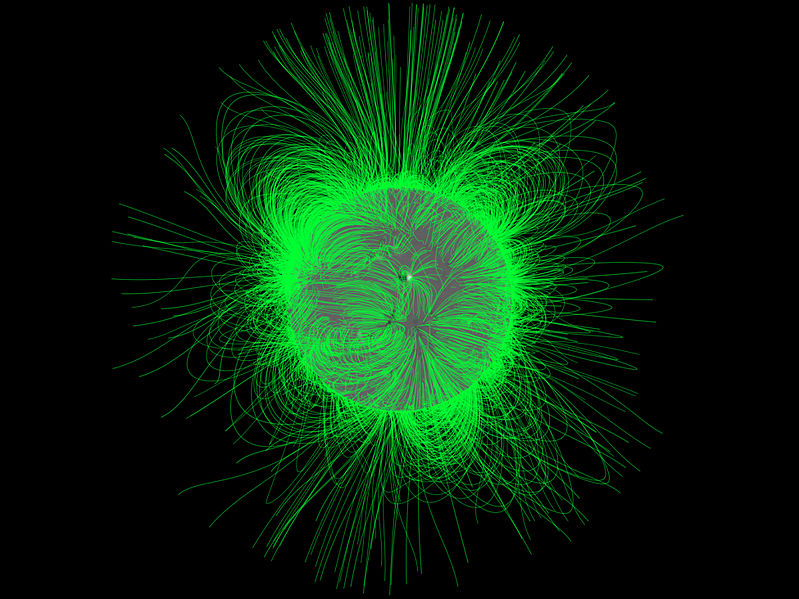In this month’s blog we take an introductory look at Solar magnetism and describe how this, together with the Sun’s rotation, leads to both Sunspots and the approximately 11-year solar cycle. The Sun’s magnetic field is both complex and extensive. Currently, there is no comprehensive model or theory which can match all the observed phenomena.
Image recorded in the extreme ultra-violet (EUV) range of the spectrum by the Solar Dynamics Observatory, February 2011. Courtesy of NASA.
The principal source of the poloidal field (North : South ‘polar’; like lines of longitude) is believed to be the differential rotation between the radiative and convective zones. The field thus generated permeates throughout the Sun. However, as the force field transits through the convective and outer regions it becomes distended; the Sun’s rotation winds the field around the Sun. This will produce the toroidal field(s) – which wrap around the sun like lines of latitude. Other mass flow within the Sun also lead to localised fields.
As the Sun rotates, the flux density of the toroidal field will also increase – the flux ‘lines of force’ will become more tightly wound with each rotation. As the Sun rotates slower at higher latitudes than at the equator, the flux density will become concentrated quicker at higher latitudes. Convection processes and magnetic pressure within the higher flux density will mean that the field will ‘break-through’ the photosphere and, with lower pressure across the photosphere, will produce a localised omega Ω shaped field. Where the magnetic flux traverses the photosphere, a sunspot will be seen.
The sunspot is seen as darker than the background photosphere because it is a cooler region than the surrounding material. The cooling is due to the radiation and convection heat transfer processes being disrupted by the magnetic force (the plasma is constrained in its movement by the magnetic field) by effects known as Biermann cooling and Alfven waves. As the sunspot has an outward and an inward direction of magnetic force (the two ‘legs’ of the Ω) the polarity of the (dipolar) sunspot will be north and south respectively; depending upon the orientation (polarity) of the generating toroidal field.
As the flux density gradually winds-up, the higher flux increases at lower latitudes and sunspots are produced at lower solar latitudes. When the flux ‘lines’ from the respective hemispheres come close at the equatorial regions, the lines of polarity become very/too close and the field ‘snaps’ (or to give its correct scientific description, magnetic reconnection occurs). At this stage, a new north-south orientated (poloidal) field (with reversed polarity) results. The process (cycle) then begins again.
The rate at which magnetic flux is permeated through the sun is known as the magnetic diffusivity of the plasma. Magnetic energy produced within the solar cycle is carried by both the poloidal field and the toroidal fields into the solar atmosphere and the corona becomes the ‘sink’ for the magnetic field energy. This is believed to be the (one of) the sources of the very high temperature (high kinetic molecular energy) seen within the corona. As you may have anticipated, the above basic description provides an overview of the current best understanding. There are many aspects and observations, which cannot yet be satisfactorily modelled. See the image below for an indication of the complexity!
NASA/Solar Dynamics Observatory 2010)
Courtesy of NASA/Goddard,
Vous trouverez dans notre livre sur le Soleil une introduction compréhensive au magnétisme avec la base atomique et physique de l’effet Zeeman qui nous permet de mesurer l’intensité du champ magnétique.



